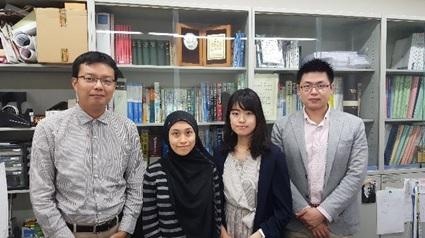Jun 14 2019
Japanese scientists have produced an inexpensive, readily available, and recyclable organic catalyst for the reduction of carbon dioxide (CO2). Since the catalytic activity level can be adjusted by the solvent conditions, their study results can possibly pave the way for many new ways of converting CO2 into useful organic compounds through industrial processes.
 (From left) Dr Ken Motokura, Associate Professor; Ria Ayu Pramudita, Doctoral Student; Chihiro Nakagawa, Master’s student from Tokyo Tech; and Dr Yuichi Manaka, Associate Professor of Tokyo Tech and AIST. (Image credit: Ken Motokura)
(From left) Dr Ken Motokura, Associate Professor; Ria Ayu Pramudita, Doctoral Student; Chihiro Nakagawa, Master’s student from Tokyo Tech; and Dr Yuichi Manaka, Associate Professor of Tokyo Tech and AIST. (Image credit: Ken Motokura)
The main area of focus in the production of next-generation catalysts for CO2 reduction is sustainability. Despite the particular attention paid by several researchers to a potential reaction known as hydrosilylation of CO2, the main drawback of most catalysts that are currently produced for this purpose is that they contain metals that are costly, limitedly available, and likely harmful to the environment.
Currently, researchers from Tokyo Institute of Technology (Tokyo Tech) and the Renewable Energy Research Center at Japan’s National Institute of Advanced Industrial Science and Technology (AIST) have shown the potential use of a completely recyclable, metal-free catalyst.
The researchers compared how well other organic catalysts could achieve hydrosilylation of CO2 and discovered one that can outperform all others with respect to yield and selectivity. This catalyst, known as tetrabutylammonium (TBA) formate, realized 99% selectivity and generated the preferred formate product with a 98% yield. The reaction took place more quickly (within 24 hours) and under moderate conditions, at a temperature of 60 °C.
Surprisingly, the catalyst carried a turnover number of about 1800, which is greater than earlier findings by an order of magnitude.
In 2015, team leader Ken Motokura of Tokyo Tech’s Department of Chemical Science and Engineering and his coworkers discovered that formate salts exhibited favorable catalytic activity, which was the basis for the present research.
Although we did expect formate salts to exhibit good catalytic activity, TBA formate showed much higher selectivity, stability and activity that went beyond our expectations.
Ken Motokura, Department of Chemical Science and Engineering, Tokyo Tech
In this work, the scientists identified that the catalyst can be used again if toluene is used as a solvent. They demonstrated that Lewis basic solvents like dimethyl sulfoxide (DMSO) and N-methylpyrrolidone (NMP) can speed up the reaction, that is, the catalytic system can be adjusted.
In general, the study outcomes, reported in the online edition of the Sustainable Chemistry & Engineering, an ACS journal, provide a new, eco-friendly method to achieve CO2 reduction along with the yield of industrially significant formate products.
It is possible to easily convert silyl formate into formic acid, which can be used as a key hydrogen carrier, for instance, in fuel cells. Its high reactivity facilitates it to get converted into intermediates to produce organic compounds like amides, carboxylic acids, and alcohols.
This efficient transformation technique of CO2 to silyl formate will expand the possibilities for CO2 utilization as a chemical feedstock.
Ken Motokura, Department of Chemical Science and Engineering, Tokyo Tech